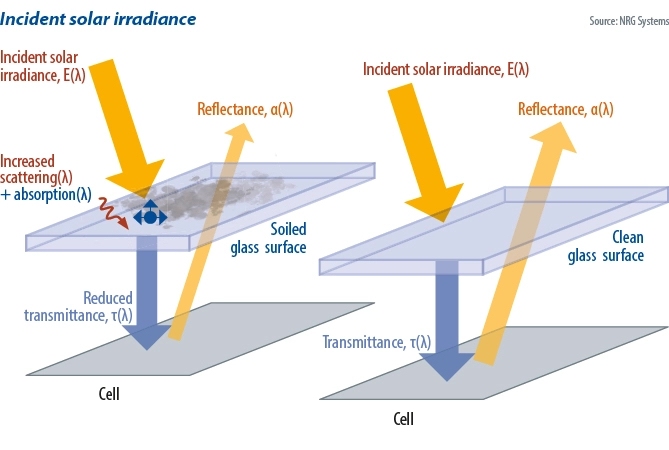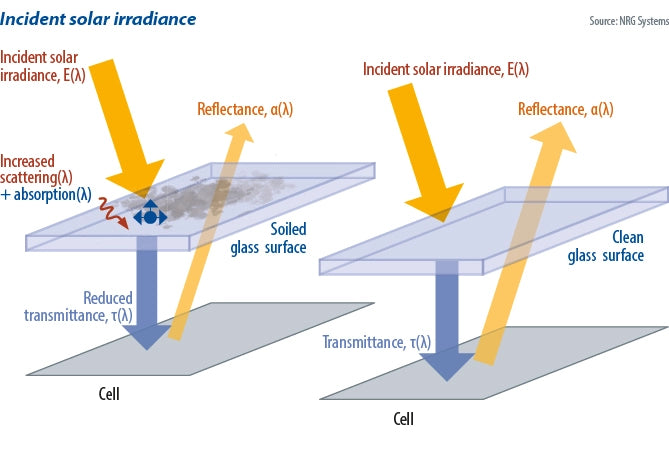https://www.pv-magazine-australia.com/2023/02/04/weekend-read-rethinking-soiling/
Weekend read: Rethinking soiling

Incident solar irradiance.
Image: pv magazine/NRG Systems
From pv magazine ISSUE 01/23
Soiling loss – the reduction in irradiance absorbed by a solar module due to the accumulation of particulate matter on its surface – is an important variable to characterise and monitor at utility scale PV plants. Surface contamination disrupts the optical processes dictating the fate of photons, meaning more solar energy is directed away from the module due to enhanced scattering at this interface.
Quantifying the overall impact of soiling comes with its own challenges, which are due in large part to the extreme variability in both the optical effects of deposited materials and the susceptibility of a site to adverse accumulation of dust and other particles. The magnitude of soiling loss for a given project depends on several parameters including those associated with geographic location, the physical properties of deposited-material, and the aggregated effects of local environmental processes that vary temporally and spatially.
Such variance makes it difficult for project developers and owners to define optimal mitigation strategies across their portfolios, which means asset owners are vulnerable to both cost inefficiency and reduced performance. Additionally, inadequately quantifying the impact of soiling increases performance uncertainty and financial risk. However, thanks to a variety of promising technical solutions now available, there appears to be progress towards a deeper and more evolved understanding of soiling-loss estimation. This knowledge will play a critical role in defining industry best practice when it comes to successful management.
Measurement methods
There are, currently, two dominant technical approaches to measuring soiling loss. The first method, represented by the IEC 61724 technical standard, includes methodologies used to directly measure current or power losses of both a clean reference module and a soiled product.
Learned experience from implementing this method has concluded that severe over- and under-estimation of true power loss can occur in scenarios involving non-uniform soiling when only the current metric is compared. Further conventional wisdom recommends using representative panel geometry and positioning as well as self-cleaning references, to reduce costs when possible. This approach has demonstrated high accuracy but is expensive and limited in that it requires an assumption of soiling loss uniformity across a site.
The other prevailing approach is the use of sensors to exploit the observable optical effects of deposited materials on the surface of a module. These devices are designed to operate autonomously to measure energy transmitted through, or reflected from, a soiled glass surface.
Equipped with these observations, it is possible to fully account for all terms in the equation that represents the partitioning of incident solar irradiance, and soiling loss can be inferred. What is problematic however, is that the relationship between transmitted energy at a single wavelength and the precise associated PV soiling loss is not fixed. This methodology, therefore, neglects two important realities: the first is that the deposited material which causes soiling has several physical properties that have a wavelength-dependent effect on incident irradiance; and the second being that each module design has a unique spectral response curve which describes how the material converts energy at different wavelengths.
Looking ahead, ongoing investigation and development initiatives are likely to advance the utility of current methodologies and generate new solutions aimed at further reducing the inefficiency and uncertainty related to soiling loss.
Perhaps most notable of the possible approaches, is the opportunity to enhance the capacity for empirical models linking more readily observable or more informative features of soiled-module measurements to a corresponding reduction in performance. For example, to overcome the inadequacies of single wavelength transmittance measurements, it might be possible to leverage observations at a combination of wavelengths to model the expected soiling loss.
Projected power
It is also possible to augment soiling-loss measurement data with models that forecast and predict the relationship between environmental conditions and soiling-related diminished PV performance. Variables such as soil component particle size, aerosol optical depth, precipitation statistics, and relative humidity can be used to understand a location’s future potential for soiling and to estimate soiling impact from an aggregation of variables plus direct observations of electrical losses and transmittance. This approach reduces the dependence on single point observation accuracy and allows for a contextualisation of data for holistic predictive modelling.
Finally, if the relationships between optical features and PV losses continue to be empirically proven and refined, the use of aerial imagery for estimating soiling could become more prevalent. Platforms for collecting and processing this type of data can be an effective tool for estimating transmittance by way of surface reflectance approximations represented by pixel brightness, to complement and scale, in-situ, observations, so that more complete estimates of project wide soiling loss are obtainable.
As solar energy development continues to grow across the globe, the need to optimise soiling measurements is paramount. By investigating these methodologies thoroughly and by leveraging data, it will be possible to refine recommendations to pave the way for more efficient and successful solar energy development.
 About the author: Alexandra E Arntsen, PhD, is the lead data scientist at NRG Systems, a company with more than 40 years of experience with measurement systems for resource assessments in the renewable energy industry. Arntsen focuses on extracting insights from observed and modelled data for solar and wind power applications. She obtained her PhD from the Thayer School of Engineering at Dartmouth College, where her research focused on modelling and observing the partitioning of solar irradiance in polar systems to better understand the global surface energy budget.
About the author: Alexandra E Arntsen, PhD, is the lead data scientist at NRG Systems, a company with more than 40 years of experience with measurement systems for resource assessments in the renewable energy industry. Arntsen focuses on extracting insights from observed and modelled data for solar and wind power applications. She obtained her PhD from the Thayer School of Engineering at Dartmouth College, where her research focused on modelling and observing the partitioning of solar irradiance in polar systems to better understand the global surface energy budget.
This content is protected by copyright and may not be reused. If you want to cooperate with us and would like to reuse some of our content, please contact: editors@pv-magazine.com.
<



